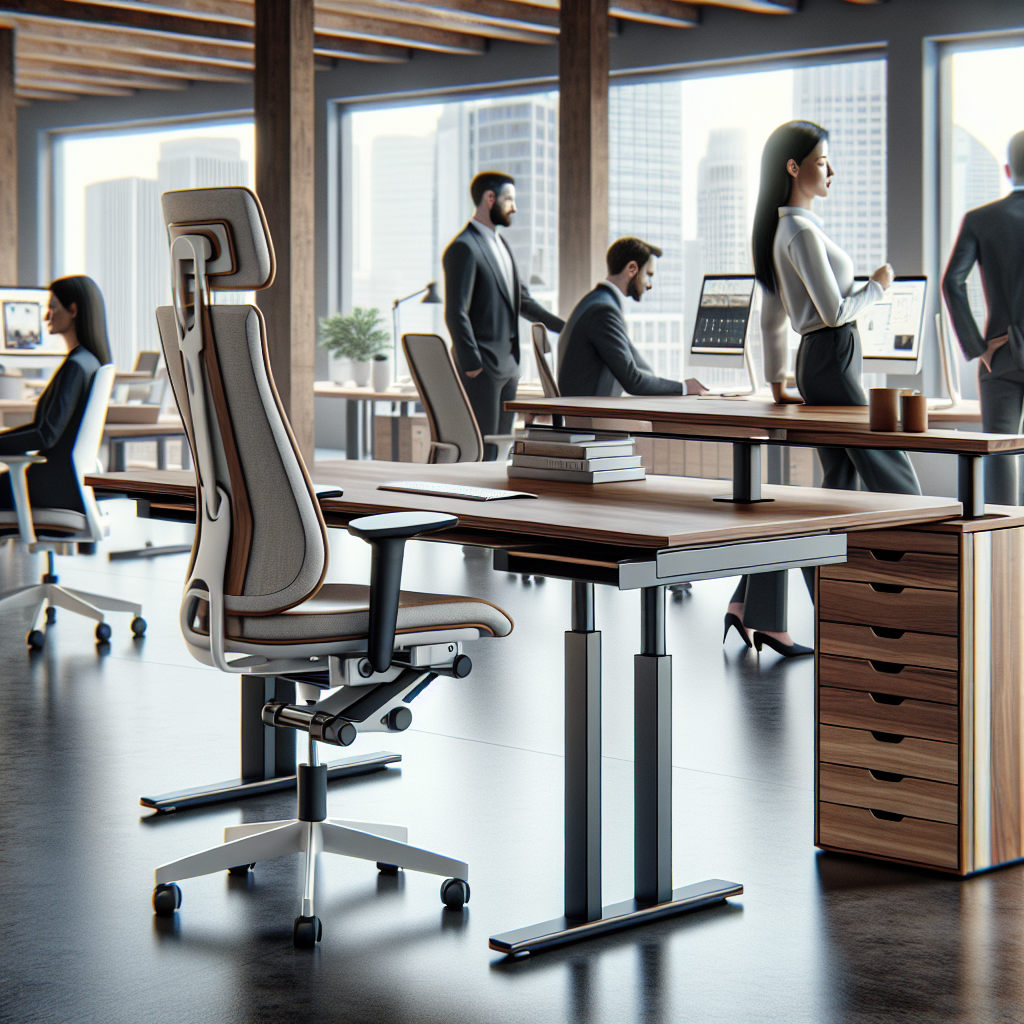In today’s fast-paced and technology-driven work environment, the importance of ergonomic desks in a modern office cannot be underestimated. These desks are specifically designed to promote comfort, productivity, and overall well-being of employees. With features like adjustable height, proper legroom, and ample workspace, ergonomic desks are a game-changer in ensuring optimal posture and reducing the risk of musculoskeletal disorders. By investing in ergonomic desks, employers prioritize the health and satisfaction of their workforce, ultimately leading to increased productivity and a happier, more efficient workplace.

Reducing Physical Discomfort and Health Risks
Preventing musculoskeletal disorders
Musculoskeletal disorders are a common workplace hazard that can result in discomfort, pain, and even long-term health issues. These disorders often occur due to repetitive or awkward movements, poor posture, and extended periods of sitting or standing. Ergonomic desks play a crucial role in preventing these disorders by promoting proper body alignment and reducing strain on muscles and joints. The adjustable height and tilt features of ergonomic desks allow users to find the optimal position for their bodies, minimizing the risk of musculoskeletal disorders.
Reducing the risk of back and neck pain
Back and neck pain are common complaints among office workers, often caused by sitting for long periods in chairs and at desks that do not provide adequate support. Ergonomic desks address this issue by offering features such as lumbar support and adjustable height options. These features allow users to maintain a neutral spine alignment, reducing the risk of back and neck pain. By investing in ergonomic desks, employers can significantly decrease the occurrence of these painful conditions and improve the overall comfort of their employees.
Promoting good posture
Maintaining good posture throughout the workday is essential for overall well-being and productivity. However, it can be challenging to maintain proper posture when sitting or standing at a traditional desk that does not offer ergonomic support. Ergonomic desks are designed to encourage good posture by providing adjustable features that allow users to customize the desk height, keyboard and mouse placement, and monitor positioning. By promoting good posture, ergonomic desks help prevent muscle imbalances, strain, and fatigue, ensuring a healthier and more comfortable working environment.
Preventing eye strain
In today’s digital age, many office workers spend a significant portion of their day staring at computer screens. Prolonged screen use can lead to eye strain and discomfort, known as computer vision syndrome. Ergonomic desks play a vital role in preventing eye strain by incorporating features that optimize the viewing experience. Adjustable monitor stands and proper desk dimensions allow users to position their screens at the correct height and distance, reducing eye fatigue and strain. Additionally, ergonomic desks often offer built-in cable management systems, reducing clutter and further minimizing eye distractions. By prioritizing eye health, ergonomic desks contribute to a more comfortable and productive work environment.
Increasing Productivity and Efficiency
Enhancing focus and concentration
The design and features of ergonomic desks are carefully engineered to enhance focus and concentration, leading to increased productivity. With customizable options such as adjustable heights and tilts, ergonomic desks allow employees to find their most comfortable and productive working positions. By reducing physical discomfort and providing support for proper posture, ergonomic desks eliminate distractions and allow employees to fully immerse themselves in their tasks. With improved focus and concentration, employees can complete their work more efficiently and effectively.
Reducing fatigue and discomfort
Fatigue and discomfort can hinder productivity and decrease overall work performance. Traditional desks often contribute to these issues by promoting poor posture and causing strain on the body. In contrast, ergonomic desks are designed to alleviate fatigue and discomfort by providing optimal support and adjustability. By allowing employees to find their ideal working positions, ergonomic desks reduce strain on muscles and joints, reducing fatigue and discomfort. Employees who are comfortable and pain-free are more likely to stay focused, motivated, and productive throughout the day.
Improving workflow and organization
The layout and features of ergonomic desks are designed to improve workflow and organization, ultimately enhancing productivity in the modern office. Ergonomic desks often incorporate various storage options, such as drawers and shelves, allowing employees to keep their workspace neat and organized. By having easy access to frequently used items and documents, employees can save time and minimize distractions. Additionally, ergonomic desks with cable management solutions help eliminate clutter caused by tangled wires, improving the overall aesthetics and functionality of the workspace. With a well-organized and efficient workspace, employees can work more smoothly and effectively.
Boosting Employee Satisfaction and Morale
Enhancing comfort and well-being
Employee comfort and well-being are essential factors in maintaining high job satisfaction and morale. Ergonomic desks prioritize employee comfort by providing adjustable features that cater to individual needs and preferences. By offering personalized comfort options, ergonomic desks ensure that employees feel supported, resulting in reduced physical discomfort and improved well-being. Creating a comfortable working environment promotes job satisfaction and contributes to a positive work culture, ultimately boosting employee morale.
Showing commitment to employee health
Investing in ergonomic desks demonstrates an employer’s commitment to employee health and well-being. By providing ergonomic workstations, employers convey the message that they genuinely care about their employees’ physical health and want to create a safe and supportive work environment. This commitment to employee health fosters a sense of loyalty and trust, enhancing employee satisfaction and building a positive employer-employee relationship. Employees who feel valued are more likely to be motivated and engaged, leading to increased productivity and overall job satisfaction.
Increasing job satisfaction and motivation
Job satisfaction and motivation are crucial factors in maintaining a positive and productive workforce. Ergonomic desks contribute to job satisfaction by promoting employee comfort, reducing physical discomfort, and enhancing overall well-being. When employees are satisfied with their working environment, they are more likely to be motivated and engaged in their tasks. The use of ergonomic desks shows that the employer values their employees’ health and happiness, further motivating them to perform their best. By investing in ergonomic desks, employers can create a positive work environment that fosters job satisfaction and motivates employees to excel.
Creating a Professional and Modern Image
Making a positive impression on clients and visitors
The appearance and ambiance of an office space have a significant impact on how clients and visitors perceive a company. Ergonomic desks contribute to creating a professional and modern image by showcasing a commitment to employee well-being and a forward-thinking approach to workplace design. The sleek and sophisticated look of ergonomic desks adds a touch of elegance and professionalism to the office environment, leaving a positive impression on clients and visitors. By investing in ergonomic desks, companies demonstrate their understanding of the importance of creating a visually appealing and comfortable workspace.
Reflecting a forward-thinking and progressive culture
In today’s competitive business landscape, it is crucial for companies to project a forward-thinking and progressive image. Ergonomic desks align with this mindset by embracing innovative design and the latest technological advancements. The integration of adjustable heights, cable management solutions, and ergonomic accessories demonstrates a company’s commitment to staying updated with the latest trends and improving the overall work environment. By incorporating ergonomic desks into their office spaces, companies showcase their modern and forward-thinking approach, positioning themselves as industry leaders in employee health and well-being.

Design and Features of Ergonomic Desks
Adjustable height and tilt
One of the key features of ergonomic desks is their adjustable height and tilt options. This feature allows employees to customize their desk to their preferred working positions, promoting proper body alignment and reducing strain on muscles and joints. By being able to raise or lower the desk to a comfortable height and adjust the tilt according to individual needs, employees can significantly reduce the risk of musculoskeletal disorders and promote good posture.
Proper desk dimensions and layout
Ergonomic desks are designed with proper dimensions and layouts to ensure optimal functionality and comfort. The desk surface dimensions provide ample space for employees to work comfortably and accommodate necessary equipment and documents. Additionally, ergonomic desks often include integrated cable management systems that keep wires tidy and out of sight, further promoting an organized and ergonomic workspace.
Cable management solutions
The organization and management of cables and wires can contribute to a neat and functional workspace. Ergonomic desks often come equipped with built-in cable management solutions, such as integrated cable trays or holes, to help keep wires organized and prevent tangling. This feature not only improves the overall aesthetics of the workspace but also reduces the risk of accidents caused by tripping over loose cables.
Ergonomic accessories
In addition to the desk itself, ergonomic accessories can further enhance the ergonomic benefits of the workstation. These accessories may include adjustable monitor stands, keyboard trays, and wrist supports. By adding these accessories to the ergonomic desk setup, employees can find their optimal positions for comfort and productivity. Ergonomic accessories help reduce strain on the neck, wrists, and hands, promoting overall well-being and reducing the risk of repetitive strain injuries.
Choosing the Right Ergonomic Desk
Considering individual needs and preferences
When selecting an ergonomic desk, it is essential to consider the individual needs and preferences of the employees who will be using it. Some employees may require a larger desk surface to accommodate multiple monitors or extra workspace, while others may prioritize storage options. Adjustable height and tilt features should also be tailored to suit the specific requirements of the employees. By considering individual needs and preferences, employers can ensure that the chosen ergonomic desk will cater to the diverse needs of their workforce.
Evaluating available space
Another crucial factor to consider when choosing an ergonomic desk is the available space in the office. It is important to measure the area where the desk will be placed to ensure that it will fit comfortably without causing any obstructions or overcrowding. Taking into account the dimensions of the desk and the layout of the office space will help determine the most suitable ergonomic desk option.
Testing ergonomics before purchasing
Before making a final decision, it is advisable to test the ergonomics of the chosen desk. Employees should have the opportunity to sit or stand at the desk and adjust the height and tilt to their desired positions. This trial will allow them to assess the comfort and functionality of the desk and determine if it meets their individual ergonomic needs. By testing the desk ergonomics beforehand, employers can ensure that the chosen ergonomic desk will provide the necessary support and comfort for their employees.

Implementing Ergonomic Desk Policies
Providing training and education on desk ergonomics
Simply providing ergonomic desks is not enough to reap the full benefits. Employers should also provide training and education on desk ergonomics to ensure that employees understand how to use the desks properly. Training sessions can cover topics such as proper posture, adjusting desk settings for comfort, and adopting ergonomic work habits. By educating employees on the importance of optimal desk ergonomics, employers empower them to take charge of their own well-being and make the most of the ergonomic features available to them.
Encouraging breaks and movement
Sitting or standing in one position for extended periods can still pose risks to employees’ health, even with ergonomic desks. It is essential to encourage regular breaks and movement throughout the workday to avoid prolonged sedentary behavior. Employers can promote a culture of movement by incorporating standing or walking meetings, encouraging stretching exercises, or providing designated break areas. By incorporating regular movement into the work routine, employers can further enhance the benefits of ergonomic desks and promote overall well-being.
Establishing a supportive work environment
Implementing ergonomic desk policies is more effective when done in conjunction with establishing a supportive work environment. Employers should foster a culture that encourages employees to prioritize their health and well-being. This can be achieved through open communication, providing resources for employee well-being, and addressing any concerns or issues promptly. By creating a supportive work environment, employers promote employee engagement and satisfaction, ensuring that ergonomic desks are utilized to their full potential.
Integration with Technology and Connectivity
Ergonomic desk compatibility with devices and gadgets
In the modern office, employees rely heavily on technology and gadgets to perform their tasks efficiently. To fully capitalize on the benefits of ergonomic desks, it is crucial to ensure that these desks are compatible with the devices and gadgets employees use regularly. Ergonomic desks should have adequate space and connectivity options to accommodate monitors, laptops, keyboards, and other peripheral devices. By integrating technology seamlessly with ergonomic desks, employees can enjoy a clutter-free and ergonomic workstation, enhancing their overall productivity and comfort.
Incorporating wireless charging and connectivity options
As the workplace becomes increasingly wireless and connected, ergonomic desks should adapt to these technological advancements. Employers should consider equipping ergonomic desks with wireless charging pads and connectivity options such as USB ports and power outlets. This integration allows employees to conveniently charge their devices without the hassle of tangled cables and enhances connectivity for seamless workflow. By incorporating wireless charging and connectivity options, ergonomic desks ensure that employees can stay connected and powered up throughout the workday.

Eco-Friendly and Sustainable Practices
Using eco-friendly materials
In today’s environmentally conscious world, the use of eco-friendly materials is becoming increasingly important in all industries. Ergonomic desks can contribute to sustainable practices by being constructed with eco-friendly materials. For example, desks made from sustainably sourced wood, recycled materials, or low-emission finishes can significantly minimize the environmental impact. By choosing ergonomic desks that prioritize environmental sustainability, employers demonstrate their commitment to eco-friendly practices and contribute to a greener future.
Recycling and waste management
Proper waste management is an integral part of eco-friendly office practices. Ergonomic desks can contribute to this by offering recycling and waste management options. For example, some desks may include designated compartments for recycling bins or hidden storage areas for waste containers. By incorporating recycling and waste management features into ergonomic desks, employers encourage responsible disposal practices and foster a sustainable work environment.
Promoting energy efficiency
Energy efficiency is a crucial aspect of eco-friendly practices. Ergonomic desks can promote energy efficiency by incorporating features such as power-saving modes, motion sensors, or programmable timers. Employers can encourage employees to make use of these energy-saving features and adopt responsible energy practices. By promoting energy efficiency through ergonomic desk design and usage, employers contribute to reducing their carbon footprint and creating a more sustainable workplace.
Cost Considerations and Return on Investment
Balancing cost with long-term benefits
While the upfront cost of ergonomic desks may be higher compared to traditional desks, it is essential to consider the long-term benefits and cost savings associated with investing in ergonomic furniture. The initial investment in ergonomic desks can result in significant cost savings over time, as they help prevent musculoskeletal disorders, reduce absenteeism, and increase employee productivity. By balancing the initial cost with the long-term benefits, employers can make an informed decision that prioritizes employee health and well-being while keeping budget considerations in mind.
Healthcare savings and reduced absenteeism
Investing in ergonomic desks can lead to substantial healthcare savings for employers. By reducing the risk of musculoskeletal disorders and promoting a healthier work environment, employers can expect fewer medical expenses related to workplace injuries or conditions. Furthermore, ergonomic desks contribute to reduced absenteeism as employees experience fewer health issues and discomfort. By minimizing the occurrence of work-related injuries and improving overall employee health, employers can realize savings in healthcare costs and maintain a more productive workforce.
Employee retention and attraction
Employee retention and attraction are critical factors in maintaining a skilled and dedicated workforce. In a competitive job market, offering ergonomic desks and prioritizing employee well-being can be a significant selling point for potential employees. The provision of ergonomic workstations demonstrates an employer’s commitment to employee health and satisfaction, making the company more attractive to job seekers. Additionally, employees who feel valued and supported are more likely to stay with the company long-term, reducing turnover and associated recruitment costs. By investing in ergonomic desks, employers can enhance employee retention and attract top talent.
In conclusion, the importance of ergonomic desks in a modern office cannot be overstated. From reducing physical discomfort and health risks to increasing productivity and efficiency, ergonomic desks offer numerous benefits to both employees and employers. By prioritizing employee satisfaction, creating a professional image, and integrating technology and sustainability, ergonomic desks contribute to a healthier, more productive, and forward-thinking work environment. When choosing ergonomic desks, considering individual needs, evaluating available space, and implementing supportive policies are essential. While there may be additional costs upfront, the long-term benefits of improved employee health, reduced absenteeism, and increased job satisfaction make ergonomic desks a worthwhile investment. So, it’s time to embrace the ergonomic revolution and create a workspace that promotes well-being, productivity, and success.




